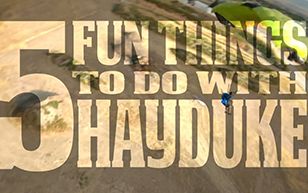Front Risers for BASE
When used properly, front risers are a tool that represents a significant portion of the controls for your parachute. We all want to be the kind of jumper and canopy pilot that does not get hurt.
Decision making and acquired skill will play the major roles in accomplishing a long injury free career. Use of your front risers will also be affected by your decision making and acquiring skill.
Your front risers steer your canopy by adjusting the trim to be steeper as more riser input is applied. Your toggles deflect air by deforming the trailing edge of your canopy to induce drag and cause your canopy to slow down as input is applied. In short, front riser input increases speed and stored energy while brake input decreases speed and diminishes stored energy. Stored energy is your friend while flying without mechanical thrust. It is easier to shed energy that has been stored, than it is to build energy once it is lost. Once energy is lost, the only way to get it back is by having adequate altitude for your canopy to regain airspeed.
Front Risers are not for every landing zone, and not for every approach. They are a valuable tool that you can choose to use in certain instances. Every application for front riser use requires adequate altitude. Second, always consider the following: Do I have room to handle the extra speed while on approach, and the possible extra glide during landing?
The answers to these questions come with experiencing the result of front riser use on your canopy in a variety of conditions. So begin with caution, extra margin, and make it a progression.
Start by adding equal input to both front risers on your next high, straight in, final approach to landing. Make sure you have room for run out. After time and practice add small sachet turns to the same approach. This will give you feedback on the extra speed gained and altitude lost while turning with front risers. Again, caution, extra margin and a progressive approach will be your ticket to success rather than the emergency room.
You should have experience using your front risers in a forgiving environment (such as at a DZ LZ) before you apply this to BASE jumping. When you are ready to apply front riser input during a base jump for the first time, your approach and the requirements will be similar to your skydiving experience. You will need room to fly, and room for run out. You can always bail on your front riser plan and use toggles.
Once you have some experience you will find the extra speed gained is very manageable and a huge benefit to your flare. The speed gained from front riser input translates into a softer landing on any surface, and more range to maneuver your parachute. You can also fly a smaller pattern thanks to the steeper flight path, allowing you to stay close to your target LZ while maintaining the energy your wing needs to sufficiently handle any abrupt change of course that may be needed. Remember, you can always trade your riser input for toggle input at any time, which adds versatility.
Your front risers are a tool. Not every tool works well for every job, but they have all certainly earned their place in the tool box. Front riser turns are not always the best way or the only way to control your parachute, but they can be a valuable option in many situations. Many experienced BASE jumpers consider front risers to be one of the most under-used tools in BASE, and more and more jumpers are beginning to use them to their advantage.
Find more information on Ben’s courses (together with Brandon Mikesell) at bmwingsuitschool.com










